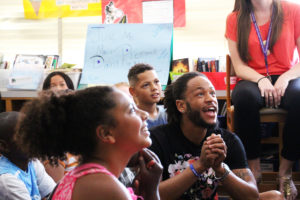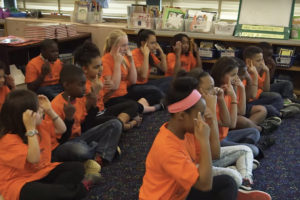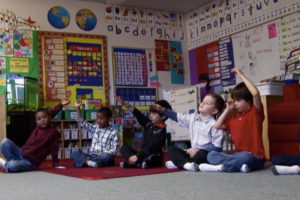If there was a way to potentially help kids pay better attention, exercise more generosity with their peers, perform better in school, and be more aware of themselves and others, would you try it? What if it was free, relatively easy and cost only a bit of your time and focus?
Reading that, it sounds too good to be true. But a recent study from Center researchers shows that it may very well be that simple. Lead Scientist Lisa Flook and team have developed a mindfulness-based Kindness Curriculum for preschoolers (you can sign up to gain free access to the curriculum).
While researchers are still researching the curriculum's effectiveness, they offer some informal tips for families who may want to start practicing more kindness and mindfulness with their young kids.
Flook and Outreach Specialists Lisa Thomas Prince and Lori Gustafson offer some tips.
While research regarding mindfulness practices for children is still at an early stage, initial results point to potential benefits in children’s ability for self-regulation. Developing an ability to focus attention is an essential skill that can aid in kids’ relationships, school, sports, music and other areas of life.
"The breath is a resource that we may not always notice, but one that is always with us."
For children and adults alike, practicing mindfulness in moments of relative calm can help strengthen the ability to make use of these strategies when emotions run high or challenges arise. As children learn by watching the adults in their lives, try joining your children in these exercises. Here are a few well-being exercises offered for families and children:
Create a Quiet Space
To balance the busyness of our lives, dedicate some time and space for quiet. Find a spot in a bedroom, a chair in the house or a bench in a local park where you and your children can pause for a few moments and develop a sense of familiarity with quiet. Notice how, when we allow our bodies to rest in quiet, our minds can settle and we may become aware of things around us and in us in a new and different way.
Pay Attention with Purpose and Curiosity
We adults often tell kids to “pay attention,” without really explaining what we mean or even how. With mindfulness, we bring our attention to whatever is happening in the present moment in the environment around us (like sounds or sights), and in our internal experience (like sensations or emotions). For example, take a walk outside and try to notice sounds of all types. Or, try a mindful eating exercise and slowly, with quiet attention, explore a food item with all of the senses before eating it – as if seeing it for the very first time, noticing the smells, colors, textures and any sensations of pleasure or displeasure.

Pause and Notice the Breath
The breath is a resource that we may not always notice, but one that is always with us. Bringing attention to the sensations and movement of the breath in the body can be calming and quieting. With children, explore the breath by having them lie on their back and notice the movement of the chest or belly as the breath moves in and out of the body. Try using other moments in the day as opportunities to bring attention to the breath as well, for example, when stopped at a red light, before answering a phone call or text message or while waiting in line.
Offer Caring Wishes
In our daily lives, we naturally encounter pleasant, unpleasant and neutral experiences. Whatever the circumstance, we can practice caring and compassion for ourselves and others by offering wishes such as, “May we be happy, may we be safe, may we be filled with love.” Caring wishes can be used when we experience discomfort before taking a test, when an emergency vehicle passes with its sirens blaring, or simply to send kindness to another person, knowing that we all wish to be happy. When we share a caring wish with others, verbally or even silently to ourselves, it can help to calm emotions and strengthen our feelings of connection.
Practice Gratitude
Asking ourselves what we are grateful for opens our eyes to the goodness around us and supports our overall sense of well-being. We can cultivate gratitude in simple ways. For example, we can take a few minutes to reflect on the good things that happened during the day, keep a list of people and things for which we are grateful and/or create a gratitude journal using words and pictures. By pausing and paying attention, we can appreciate things we might otherwise take for granted such as the warmth of the sun, clean water to drink, a neighbor’s smile and even our breath.






